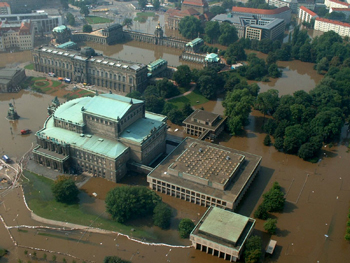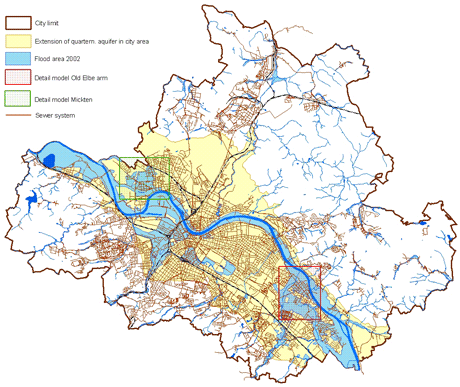
The objective of the project 3ZM-GRIMEX is the development of a software system for just such a coupled simulation. The strategy is to use established simulation programs for each component and MpCCI (Mesh-based Parallel Code Coupling Interface) for combining the codes into one simulation tool.
The involved codes are RisoSurf (Fraunhofer Institute ITWM) or TrimR2D (Public Domain) for the surface, Hamoka (University of Kaiserslautern) or Hystem-Extran (Institut für technisch-wissenschaftliche Hydrologie, Hannover) for the sewer system and PCGEOFIM (Ingenieurbüro für Grundwasser GmbH, Leipzig) for the groundwater. In these codes partial differential equations are numerically solved; shallow-water equations are used in one dimension for the sewer system and two dimensions for the surface flow, and Darcy´s Law in three dimensions is used for the groundwater.
The pilot application area in the project is the urban region of Dresden. Here the simulated area is divided into a global model and a few local models. The global model extends parallel to and on either side of the river Elbe (the area with the yellow background in Figure 2), where buildings and streets are only roughly taken into account and the sewer system is modelled without details. Here the combination of the programs TrimR2D, Hystem-Extran and PCGEOFIM is applied. The local models (illustrated by coloured rectangles in Figure 2) are computed with details on the surface, such as buildings and curbs, and with more manholes in the sewerage system. In this case the combination of the programs RisoSurf, Hamoka and PCGEOFIM is used.

Identifying and defining the relevant water flows between the individual components of the flow system was an important step of the project. The implementation of these interactions is based on MpCCI (Fraunhofer Institute SCAI). MpCCI manages the communication between the individual programs: the mapping between the different model geometries, the time synchronization, and the data exchange including spatial interpolation.
The flow system includes diverse states depending on the expansion of the flood. Each of the individual simulation components works with its own boundary conditions and sends one quantity to and receives one quantity in return from each of the other components. For example, for the coupling between the surface water program and the groundwater code the coupling areas are given by the potentially flooded elements (triangles or rectangles) of the surface model and by the top side of the three-dimensional volume cells nearest to the surface of the groundwater model. The quantity sent by the surface program is the water height in metres above ground level at the cell centre. The quantity sent in return by the groundwater code is the water velocity (or water flux per area) measured in metres per second. The same procedure is applied to each of the other two combinations: the surface code and groundwater code respectively with the sewerage simulation.
Since the three components have different simulation dynamics, a customized coupling algorithm had to be invented. Having faster dynamics, the programs for the surface flow and the sewerage system must couple more frequently with each other before they both couple with the groundwater.
The coupled simulation is implemented and validated for a generic test model. For some local models, simulations have already been successfully performed. Work is continuing on the global model simulation. The 2002 flood will be simulated with and without planned protection measures. The city of Dresden is interested in the effects of these measures on future floods.
The partners in the project 3ZM-GRIMEX are: DGFZ Dresdner Grundwasserforschungszentrum e.V., TUD Technische Universität Dresden, ITWM Fraunhofer Institut für Techno- und Wirtschaftsmathematik, SCAI Fraunhofer Institut für Algorithmen und Wissenschaftliches Rechnen, UFZ Umweltforschungszentrum Leipzig-Halle GmbH and Umweltamt Landeshauptstadt Dresden. The project started in March 2005 and is expected to finish in June 2008. It is funded by the German Federal Ministry of Education and Research (BMBF) within the research focus RIMAX.
Links:
http://www.dgfz.de/hochwasser/3ZMGRIMEX
http://www.mpcci.de/fileadmin/mpcci/Userforum/MpCCI_8th_UserForum.pdf
Please contact:
Jörg-Volker Peetz
Fraunhofer Institute for Algorithms and Scientific Computing SCAI, Germany
Tel: +49 2241 14 2945
E-mail: joerg-volker.peetz![]() scai.fraunhofer.de
scai.fraunhofer.de










